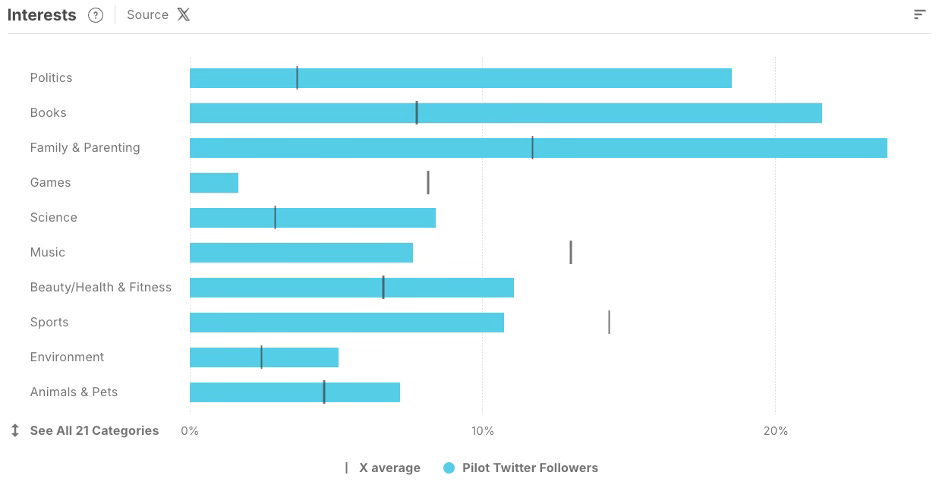What can social listening tell us about the bridge-building movement?
Summary: More in Common analyzed user data from nearly a million followers of bridge-building organizations on X (formerly Twitter). Here we share how these social media users compare to typical X users. You can read about our research in full here.
On social media platforms, outrage is the name of the game. Log onto X, and you’ll probably be inundated with angry posts. This is hardly an accident: Social media algorithms prioritize posts that encourage higher user engagement and unsurprisingly, provocative posts are more engaging. With these dynamics, how can bridge-building organizations, whose content is inherently depolarizing, build an online presence?
For the past year, More in Common explored how organizations in the U.S. that focus on bridging across divides and reducing toxic polarization (what we’re calling “bridge-building” organizations) are showing up online and how they can grow more effectively. This effort culminated in a comprehensive, field-tested toolkit that provides organizations with practical guidance on how to grow their social media presence.
Today’s newsletter highlights one part of the research we conducted to build this toolkit. Before we could provide advice on growth, we needed to understand the audience for bridge-building organizations on social media.
We collected available follower data through web-scraping from a sample of 88 U.S.-based bridge-building organizations that that have some focus on bridging and reducing toxic polarization in the US at the national level, and have a social media presence. To limit scope and ensure clarity, we analyzed one platform, X (formerly Twitter).
Why X? While bridge building organizations use a variety of social media platforms, X is currently one of the best social media platforms for analysis. Most profile and interaction data are public by default, and the relationships between users are clear, with followers/following relationships well-defined and engagement visible through replies, mentions, and retweets. Its application programming interface (API) is also one of the most accessible to researchers for web scraping and social listening using third-party tools.
Who follows bridge-building organizations on X?
These 88 organizations had around 850,000 unique followers. We analyzed their posts, replies, and bios (the information that makes up their public profiles) via Brandwatch, a powerful tool for analyzing social media content. To see how these users differ from the typical X user (such as interests, professions), we looked at what’s shared publicly on users’ profiles.
The following graphs depict the X followers of the 88 organizations studied (blue bars) and compare them to X’s overall average (black vertical lines).
This bridge-building audience skews more female than male—the opposite of what’s typical overall.
Users who follow bridge-building organizations skew somewhat more female than male (53 % female, 47% male), whereas X overall skews more male than female (55% male, 45% female).
This bridge-building audience is much more interested in politics, books, and family/parenting than X’s norm, but less interested in games, music, and sports.
Users who follow these bridge-building organizations express interest more often in politics (19% vs. 4%), books (22% vs. 8%), and family & parenting (24% vs. 12%) than what’s typical for X.
They also express interest in science (8% vs. 3%) and beauty/health & fitness (11% vs. 7%) at higher rates than X’s broader audience. Conversely, X users overall more often express interest in games (8% vs. 2%), music (13% vs. 8%), and sports (14% vs. 11%).
This bridge-building audience is more likely to be educators and journalists than the norm, but less likely to be artists, students, or software developers.
Based on their X profiles, users who follow these bridge-building organizations are more likely than X users overall to be teachers & lecturers (23% vs. 8%), journalists (16% vs. 4%), and scientists & researchers (10% vs. 7%).
Conversely, a greater percentage of overall X users are artists (30% vs. 17%), students (14% vs. 7%), or in software development & IT (8% vs. 3%). Politicians make up a very similar – albeit low – percentage of both the bridge-building audience and overall X users.
This bridge-building audience is often talking about politics/current events online.
This wheel displays the topics most discussed by the Twitter/X followers of the 88 organizations throughout the months of April, May, and June 2025. Here, Trump is a main topic theme, as shown in the inner ring, with the outer-ring words reflecting major sub-themes. For example, “Iran” is a sub-theme discussed under the umbrella of conversations about Trump.
So, why is this useful?
In today’s media landscape, advancing pluralism and bridging divides requires more than leading meaningful research and programs — it also demands effective communication that can shape norms and reach broad audiences.
For bridge-building organizations, we hope these findings help you better understand the bridge-building field’s online audience, and identify where there might be opportunities to broaden engagement and reach new people. Whether you’re on X or not, rethinking your content strategy, highlighting new messengers, or experimenting with creative formats can help bring in the communities you’re missing. Our toolkit offers tested, practical steps to guide that shift for an array of platforms.
For individuals interested in bridging divides, we hope these findings make you think about your position in this space. Are you a lot like other bridge-building audience members, or are you very different? Either way, your perspective matters. If your voice or community isn’t well represented in this space, consider how you can help bring others in. Amplify content from organizations you admire. Tell stories and share examples of bridging happening in your own community. Engage in experiences in your local community where you are meeting people who are different from you — and bring a friend to join. How can you play a part in creating a culture of connecting across difference?
We can’t do this without you!
MIC regularly conducts research that sheds light on both cross-group misperceptions and common ground. Consider supporting our work by making a donation.







